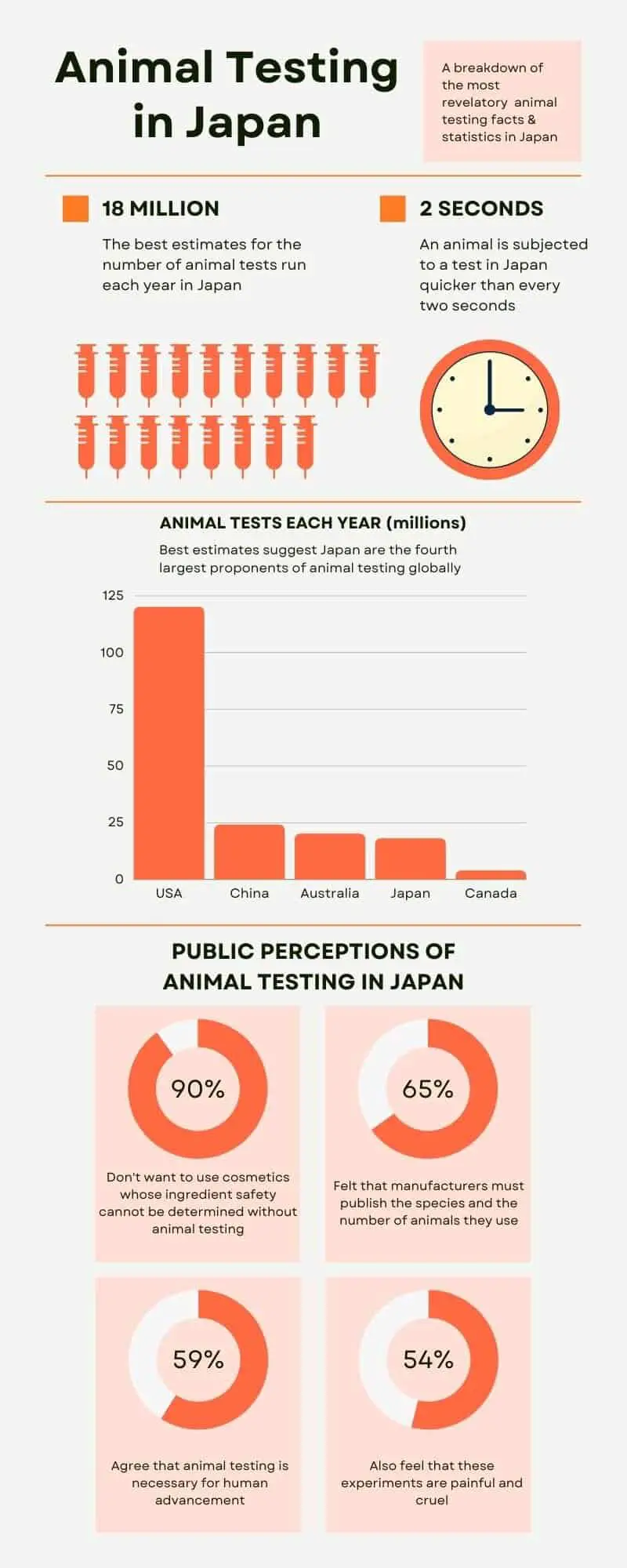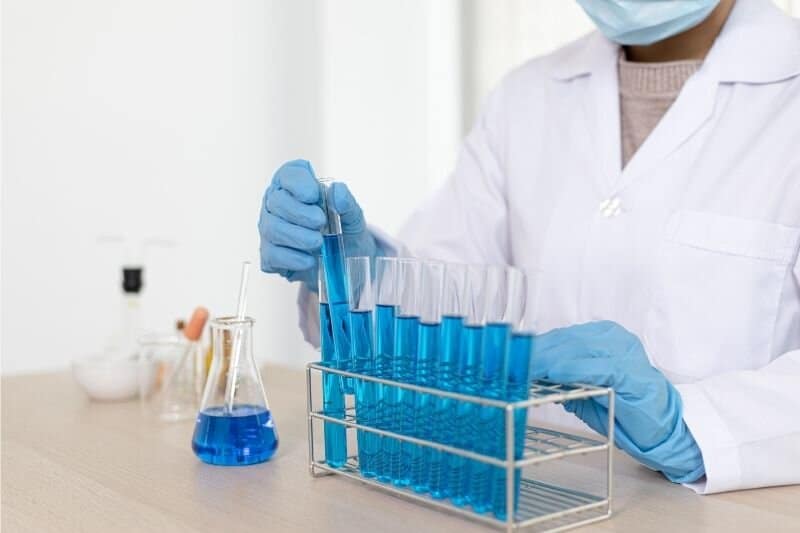- This post may contain affiliate links which - at no cost to you - may generate a small fee for us. It helps us research and review products more effectively
- Animal testing on cosmetics – or any product – is not a requirement for the Japanese market. But this is only a recent development
- Japan has one of the highest uses of experimental animals for medical and life science research in the world
- Although worldwide Japan is one of the top 5 worst proponents of animal testing
- And Japan has no laws in place that ban animal testing
Is Animal Testing Legal in Japan?
Animal testing is legal in Japan. Whilst it is only mandated in special circumstances, testing on animals in Japan is spectacularly commonplace.
There are no laws or legislation in place to prevent companies from testing on animals in any scenario to gauge product or ingredient efficacy.
What’s on this page?
Does Japan Require Animal Testing on Cosmetics?
No Japanese law does not require animal testing on cosmetics anymore. But nor does it ban it. Or even provide any strict regulations about testing the safety and efficacy of products and ingredients.
Previously Japanese law did require that quasi-drugs – like skin-lightening products, suntan lotion, and hair growth tonics – be tested on animals when new ingredients are added.
Fortunately in 2011 the Japanese Center for the Validation of Alternative Methods (JaCVAM) accelerated applications for new, animal-friendly test methods developed when new ingredients are added to quasi-drugs and cosmetics.
Top 11 Animal Testing Facts & Statistics in Japan
1. Best estimates suggest Japan performs 18 million animal tests each year. Only China, the USA and Australia perform more
Source: Animal Testing Statistics
2. Japan performs more tests on animals than the entire EU each year
3.An animal test is performed in Japan roughly every 1.75 seconds
4. 55 – 62% of the Japanese public agreed with practical training involving animal testing was necessary for human advancement
Source: NCBI
5. 51 – 57% also felt that these experiments are painful and cruel
6. However in a 2016 survey between LUSH and the HSI, 90% of the Japanese public stated that they didn’t want to use products whereby the only way to confirm ingredient safety is to test on animals
Source: Cruelty Free Kitty
7. 65% also felt that companies who do test products or ingredients on animals should have to stipulate what type(s) of animals and how many
8. Japan has no law – or clear plan in place – designed to ban animal testing
9. The Japan Anti-Vivisection Association (JAVA for short) continue to call for a ban on animal testing in Japan
Source: Euro Group for Animals
10. 13 major Japanese companies – including Asahi – have instituted policies that banned animal testing – but not when selling products into markets where testing can be required by law
Source: Food Navigator Asia
11. Anyone can establish an animal testing facility in Japan without even a permit or permission

Animal Testing Policies in Japan
Ultimately there are very few animal welfare policies in Japan that relate to animal testing. None if we just consider cosmetic animal testing. And these laws and regulations are, at best, vague and provide minimal protection for animals
Act of Welfare and Management of Animals
Apparently the purpose of this act was to foster a ‘collective spirit’ for animal welfare amongst Japanese citizens. The fundamental principles of the act include:
- No person shall destroy, injure or inflict cruelty on animals without reason
- When handling an animal every person must secure an environment for carrying out appropriate care – feeding, watering and all necessary health management
- National and local governance must make an effort to promote educational awareness designed to rais ewelfare and proper care of animals
Whilst this law was created in 1973, it was amended in 2005 with key points related to The Three R’s – Replacement. Reduction. Refinement. All designed to avoid the use of animals for testing purposes where possible and reduce and refine to minimise suffering where ‘necessary.’

Standards Relating to the Care and Management of Laboratory Animals
Fairly self-explanatory (one would hope!), but the Standards Relating to the Care and Management of Lab Animals Act is just that.
And this act is designed to:
- Provides general principles for the treatment of animals under scientific purposes
- The selection of animals – in the sense that lab animals are considered based on conditions and lab practicalities
- Provides guidance to standard bearers as to how to maintain objectivity and establish a committee
Basic Guidelines for Conducting Animal Experiments at Research Institutes
The act focused on Basic Guidelines for Conducting Animal Experiments is, again, fairly self-explanatory.
- A scientific understanding of life means that some animal experimentation is unavoidable – we assume this act isn’t including cosmetics here
- The responsibilities of the research heads to establish a committee for animal care, examining whether the experiments are carefully managed
- And that the experiments ensure scientific rationality and have considered all alternatives, selected appropriate animals and used The Three R’s
- Finally, when all else fails, used appropriate pain relief
The Validation of Alternatives to Animal Testing
Japan was one of four international bodies (The EU, Japan, USA and Canada) to signed a 2009 agreement for The International Cooperation on Alternative Test Methods. An agreement designed to validate alternatives to animal testing and replace, reduce and refine the number of animals used in tests worldwide.
In setting up and maintaining databases on alternative testing methods – available to the international community – the goal is to educate countries about available alternatives with pre-approved trial data.
In 2014, the European Business Council released a white paper that demanded an improvement in data collection validating alternatives to animal testing. The EBC even went as far as calling on the Japanese authorities to honour their commitment (or lack of) to honour its international commitment to animal welfare and the environment.
JaCVAM – Japanese Centre for the Validation of Alternative Methods
Did you know? – since 2010, the JaCVAM has played an active role in gaining approval for the adoption of OECD test guidelines for 16 different test methods developed by Japanese researchers
The JaCVAM – a centre setup to promote The Three R’s in animal experiments for assessing the safety of ingredients in Japan and establish guidelines for new alternative experimental methods through international collaboration.
IN 2011, the Japanese Ministry of Health, Labour and Welfare (MHLW) approved the use of data obtained with JaCVAM approved alternative test methods could be used for the submission of quasi-drug applications.
The website is loaded with information to help companies document their applications for approval of quasi-drug products as well as in requests for revisions to the positive list for cosmetics.
FAQs
Whilst Japan doesn’t mandate the testing of cosmetics – or require animal testing for the safety of any products anymore – animal testing on cosmetics can still occur in special circumstances as it is not illegal.
Yes a cosmetics company can sell products in Japan and still be cruelty-free as Japan doesn’t mandate animal testing on cosmetics for safety purposes.

